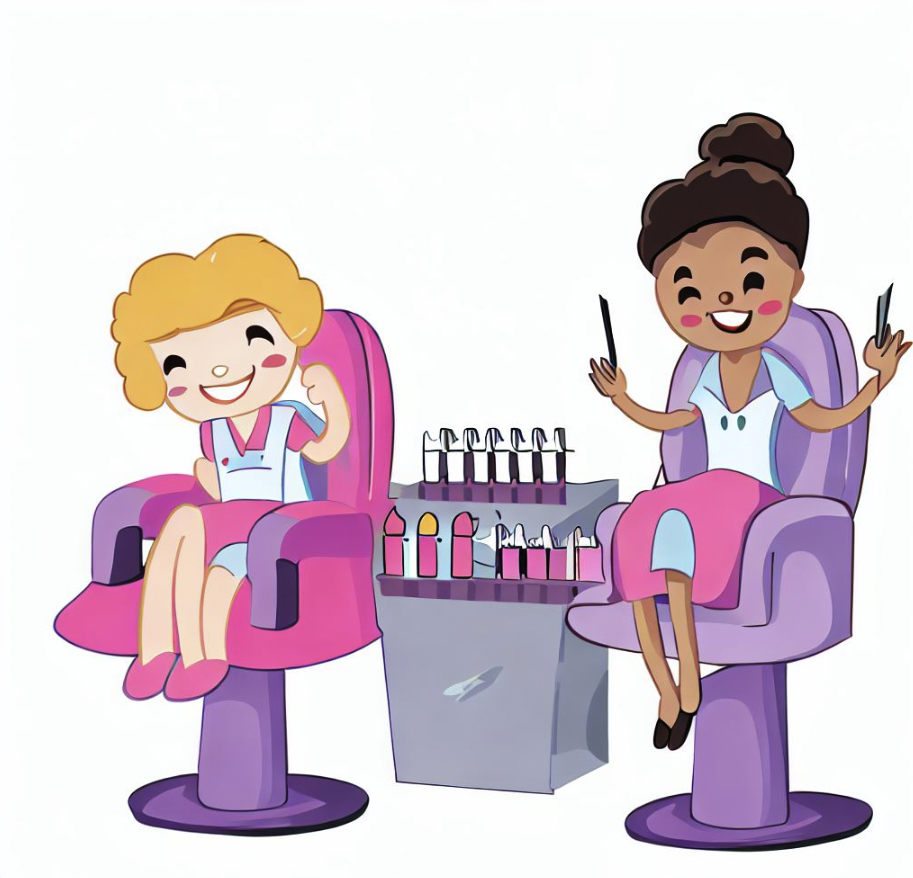In the bustling streets of many American cities, the sight of nail salons with Vietnamese names or Vietnamese-speaking staff has become a familiar scene.
But have you ever wondered why a significant portion of these establishments are owned and operated by individuals of Vietnamese descent?
Let’s look into the history and the economic dynamics that have led to this phenomenon.
A Flourishing Business: The Vietnamese Dominance in the Nail Salon Industry
Did you know that over 80% of nail salon owners in California are Vietnamese?
This high ownership of Vietnamese nails salons is not just confined to the Golden State.
Nationwide, 50% of nail salon owners are Vietnamese.
This dominance in the industry is not a mere coincidence but the result of a series of historical and socio-economic factors that have played out over several decades.
The Genesis of a Revolution: Making Nail Services Accessible
In the latter part of the 20th century, Vietnamese entrepreneurs began to revolutionize the nail salon industry.
They introduced discount services, making nail care and beautification more accessible to a broader segment of the population.
This shift not only democratized the industry but also fueled its growth, making nail salons a popular choice for affordable pampering and grooming.
A Community Affair: Family and Friendship Bonds
The nail salon business became a beacon of opportunity for many Vietnamese immigrants.
It offered a space where families and friends who migrated to the US could work alongside each other, fostering community bonds and pooling resources to establish and grow their businesses.
This community-centric approach has been a cornerstone in the success and proliferation of Vietnamese-owned nail salons across the country.
Other Examples of Business Dominated by Certain Ethnicities
- Jewish Participation in Banking and Finance: Historically, Jews in Europe were often restricted from owning land and participating in various guilds and trades. Banking was one of the few professions that was open to them, particularly because Christian usury laws did not apply to Jews. This led to a long-standing association of Jews with banking and financial sectors.
- Indian Motel Owners: A significant proportion of motels in the United States, especially budget ones, are owned by Indian-Americans, particularly those of Gujarati descent. This phenomenon started when early Indian immigrants took jobs at motels and hotels and eventually saved enough to buy out these businesses.
- Chinese Restaurants: Chinese immigrants in many countries have often turned to opening restaurants as a way to make a living. This industry was accessible because it required relatively low start-up costs and could cater to a wide audience by adapting traditional Chinese dishes to suit local tastes.
- Italian Americans in Construction and Masonry: In many parts of the United States, Italian immigrants became associated with skilled trades such as construction, stonemasonry, and carpentry. Their skills in these areas, passed down through generations, helped them establish a foothold in these industries.
Q&A – Are Nail Salons Usually Vietnamese?
Why are many nail salons owned by Vietnamese individuals?
The prevalence of Vietnamese-owned nail salons in the U.S. can be traced back to the aftermath of the Vietnam War.
After the fall of Saigon in 1975, many Vietnamese refugees came to the U.S. in search of a better life.
Tippi Hedren, a Hollywood actress, played a pivotal role in this trend.
She visited a refugee camp in California and, noticing the refugees’ admiration for her nails, decided to bring her personal manicurist to teach a group of 20 Vietnamese women the art of manicuring.
This initial group of women went on to open their own salons or work in the industry, and they trained others in the Vietnamese community.
The low startup costs, the ability to learn the trade quickly, and the opportunity to be self-employed made the nail salon business an attractive option for many Vietnamese immigrants.
How did the Vietnamese community come to dominate the nail salon industry in the U.S.?
The Vietnamese community’s dominance in the nail salon industry grew organically from the initial group trained by Tippi Hedren.
As more Vietnamese immigrants arrived in the U.S., those already in the nail business trained newcomers, creating a ripple effect.
The community’s tight-knit nature facilitated the sharing of knowledge, resources, and opportunities.
Additionally, the nail salon business did not require advanced English skills, making it accessible for recent immigrants.
Over time, Vietnamese entrepreneurs established a strong presence in the industry, leading to a network effect where new entrants would naturally gravitate towards the nail salon business due to existing community support and success stories.
What historical and socio-economic factors contributed to the rise of Vietnamese-owned nail salons?
Several historical and socio-economic factors contributed to the rise of Vietnamese-owned nail salons:
- Vietnam War and its Aftermath: The end of the Vietnam War led to a significant influx of Vietnamese refugees to the U.S. These refugees were looking for livelihood opportunities, and the nail salon industry presented a viable option.
- Low Startup Costs: Opening a nail salon required relatively low capital compared to other businesses. This made it feasible for immigrants with limited resources.
- Quick Training: The skills required to become a manicurist could be acquired in a short period, allowing rapid entry into the workforce.
- Language Barrier: The nail salon business did not necessitate advanced English proficiency, making it an attractive option for recent immigrants.
- Community Support: The Vietnamese community in the U.S. is known for its strong sense of solidarity. This community support provided a safety net and resources for newcomers to venture into the nail salon business.
How has the Vietnamese community influenced the nail salon industry in terms of services, techniques, and trends?
The Vietnamese community has significantly influenced the nail salon industry in various ways:
- Affordability: Vietnamese-owned nail salons often offer services at more competitive prices than other salons, making manicures and pedicures accessible to a broader clientele.
- Innovations: The community has introduced various nail techniques and styles, such as the “dip powder” method and unique nail art designs.
- Efficiency: Many Vietnamese nail salons are known for their quick yet quality service, catering to clients with busy lifestyles.
- Expansion of Services: Over time, many Vietnamese nail salons have expanded their service offerings to include other beauty services like waxing, facials, and eyelash extensions.
Are there specific regions or states where Vietnamese-owned nail salons are more prevalent?
Yes, Vietnamese-owned nail salons are more prevalent in states with larger Vietnamese immigrant populations.
California, particularly in areas like Orange County (home to Little Saigon, the largest Vietnamese community outside of Vietnam), Los Angeles, and the San Francisco Bay Area, has a significant number of Vietnamese-owned nail salons.
Other states with notable Vietnamese populations, such as Texas (especially in Houston), Nevada (especially in Las Vegas), Washington, and Louisiana, also have a higher prevalence of Vietnamese-owned nail salons.
How do Vietnamese nail salons differ from other nail salons in terms of service and customer experience?
Vietnamese nail salons often stand out in the following ways:
- Cost-Effectiveness: They typically offer services at more competitive prices, providing value for money.
- Efficiency: Many Vietnamese nail salons are known for their ability to serve customers quickly without compromising on quality.
- Personal Touch: Given the close-knit nature of the Vietnamese community, many salons have a familial atmosphere, leading to a more personalized customer experience.
- Innovative Techniques: As mentioned earlier, Vietnamese nail technicians have introduced various nail techniques and styles that might not be commonly found in other salons.
What challenges have Vietnamese entrepreneurs faced in establishing and running nail salons?
Vietnamese entrepreneurs in the nail salon industry have faced several challenges:
- Language Barrier: While the nail industry might not require advanced English skills, language barriers can still pose challenges in business operations, negotiations, and customer interactions.
- Regulations and Licensing: Navigating the regulatory landscape and ensuring compliance with state and local licensing requirements can be daunting.
- Competition: Given the proliferation of nail salons, especially in areas with a high concentration of Vietnamese-owned establishments, competition can be fierce.
- Health Concerns: The use of chemicals and solvents in nail salons has raised health concerns for workers, leading to the need for better ventilation and safety measures.
- Economic Fluctuations: Like many small businesses, nail salons can be vulnerable to economic downturns, which can impact customer spending.
How has the nail salon industry impacted the socio-economic status of the Vietnamese community in the U.S.?
The nail salon industry has played a significant role in elevating the socio-economic status of many Vietnamese immigrants in the U.S.:
- Employment Opportunities: The industry has provided employment for a large number of Vietnamese immigrants, helping them establish a foothold in the U.S. economy.
- Entrepreneurship: Many Vietnamese individuals have transitioned from employees to business owners, leading to wealth creation and economic independence.
- Community Development: The success of Vietnamese-owned nail salons has led to investments in other community ventures, further bolstering the community’s economic strength.
Are there any cultural or traditional practices from Vietnam that are incorporated into Vietnamese nail salons?
Yes, some Vietnamese nail salons incorporate cultural and traditional practices:
- Decor: Many salons feature Vietnamese art, symbols, and decor elements, providing a touch of Vietnamese culture.
- Traditional Treatments: Some salons offer treatments using traditional Vietnamese ingredients and methods, such as herbal foot soaks or massages with Vietnamese techniques.
- Festive Celebrations: During Vietnamese festivals like Tết (Lunar New Year), salons might have special decorations, offers, or even traditional Vietnamese music playing.
The Ripple Effect: Beyond Business
The Vietnamese dominance in the nail salon industry has had ripple effects that extend beyond the business realm.
It has facilitated the creation of supportive communities, fostering unity and solidarity among Vietnamese immigrants.
Moreover, it has paved the way for subsequent generations to carve out successful paths in various other sectors, building on the entrepreneurial spirit and resilience exhibited by the pioneers in the nail salon industry.
A Cultural Exchange: Infusing Vietnamese Traditions into the Industry
The influence of Vietnamese culture can be seen in the nail salon industry, from the warm and hospitable service to the intricate nail designs inspired by Vietnamese art and traditions.
This cultural infusion has enriched the industry, offering clients a unique and immersive experience that goes beyond mere nail care.
Building Bridges: Fostering Understanding and Integration
The Vietnamese-owned nail salons have also served as bridges, fostering understanding and integration between different communities.
Through their interactions with clients from diverse backgrounds, they have facilitated cultural exchanges and dialogues.
Conclusion
The Vietnamese community’s dominance in the nail salon industry is a testament to their entrepreneurial spirit, resilience, and the strength of community bonds.
Through their efforts, they have transformed the industry, making nail care services more accessible and popular among the public, while also fostering a rich cultural exchange and building bridges between communities.
Related


